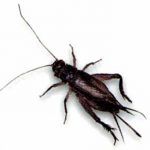Votre panier est actuellement vide !

The cricket
Insects of black or brown color. They measure more than 13 mm long. Their head has long antennas. They have two compound eyes. Mouth parts of the crusher type with powerful mandibles. The thorax carries the organs of locomotion, that is to say three pairs of legs and two pairs of very ribbed wingsThe front wings are rather resistant, they are used as a protective case for the membranous posterior wings, folded in fan at restthe pair of posterior legs is specialized for the jump. The abdomen ends with two sensory filaments
Latin Name: Acheta domestica
Description: Black or brown insectsThey are more than 13 mm longTheir head bears long antennaeThey have two compound eyesMill-type mouthparts with powerful mandiblesThe thorax bears the organs of locomotion, namely three pairs of legsand two pairs of highly ribbed wingsThe forewings are rather tough, They serve as a protective case for the membranous hindwings, folded into a fan at restThe pair of hind legs is specialized for jumpingThe abdomen ends with two sensory filamentsThe female can be distinguished from the male by the presence of the ovipositor, a long egg-laying organ of cylindrical shape located between the two sensory filaments
Reproduction: Adult crickets mate following a sexual display during which the male rubs his wings together and « sings ». The male then emits a spermatophore,which is a whitish gelatinous envelope in the shape of a drop that contains the spermatozoa. After a few seconds, the female tears the spermatophore to release the spermatozoa, which then migrate inside her reproductive organs. A few days later, the female finds a suitable place to lay eggs. She carefully pushes her ovipositor into the ground and lays her eggs.The laying of about a hundred eggs takes several days.After the incubation of the eggs, the duration of which varies according to the species and the environmental conditions, tiny crickets are born, similar to adults but without wings. The cricket is an insect with incomplete metamorphosis, or hemimetabole.During their growth, young crickets undergo several molts that allow them to grow to the adult stage, with complete wings and functional reproductive organs.
Habits:The house cricket, as its name implies, usually lives in homesand other human constructions. It is often found where the temperature is high,such as in heating pipes as well as behind radiators and heaters. They are fond of bakeries and can even be found in subway stations. In warm weather, it can be found outdoors where it frequents especially dumps and other piles of garbage. Spring and fall crickets are found in fields, roadsides, and yards adjacent to homes, where they may also enter.These omnivorous insects feed on leaves, seeds, fruit, other dead and live insects, food debris, peelings, cooked meat, and baked goods, among other things.